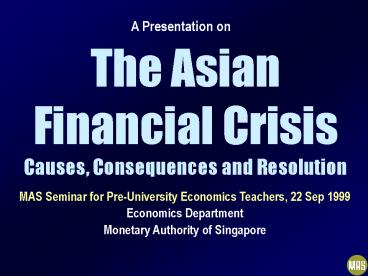The Asian Financial Crisis Causes, Consequences and Resolution - PowerPoint PPT Presentation
1 / 60
Title:
The Asian Financial Crisis Causes, Consequences and Resolution
Description:
'What role hedge funds played (during the Asian financial crisis) in different ... Regulating indirectly through lenders who provide hedge funds with the financing? ... – PowerPoint PPT presentation
Number of Views:163
Avg rating:3.0/5.0
Title: The Asian Financial Crisis Causes, Consequences and Resolution
1
The Asian Financial CrisisCauses, Consequences
and Resolution
A Presentation on
MAS Seminar for Pre-University Economics
Teachers, 22 Sep 1999 Economics
Department Monetary Authority of Singapore
2
Outline
- Causes of the Crisis
- What Happened?
- Policy Responses
- Macroeconomic Stabilisation
- Structural Reforms
- Recovery Prospects and Risks
3
Causes of the Crisis
- Macroeconomic vulnerabilities
- Foreign capital inflows
- Financial sector vulnerabilities
4
Pre-crisis Macroeconomic Fundamentals
5
High real GDP growth
6
Low CPI inflation
7
Sound fiscal balancesBudget balance as of GDP
Indonesia
Malaysia
Thailand
Korea
8
Low Public Debt
9
High Savings Rate
10
Where were the warning signals? Sources of
Macroeconomic Vulnerabilities
11
Sharp rise in domestic credit
Indonesia
Malaysia
Thailand
Korea
12
High domestic leverage
Domestic Credit to GDP Ratio ()
Indonesia
Malaysia
Thailand
Korea
13
Over-investment in
- Property and stock markets
- Industries with excess capacity
- Mega infrastructure projects
14
Persistent current account deficits
Indonesia
Malaysia
Thailand
Korea
15
The Role of Foreign Capital Inflows
16
Impact of large, volatile capital flows
- Fuelling investment booms
- Dependence on short-term capital inflows makes
economies vulnerable to a liquidity crisis when
there is a sudden withdrawal - Reversal of capital flows in a highly-integrated
global financial market generates contagion
effects on exchange rates, interest rates and
stock prices
17
Net Private Capital Inflows to Asia, Developing
Countries
18
Euphoria in the 1990s.
Financial market opening
Low interest rates in the G3 countries
Good macroeconomic fundamentals in Asia
Massive capital inflows into Asia
19
High ratios of short-term foreign debt to foreign
reserves
1996
20
Financial Sector Vulnerabilities
21
Areas of financial sector weaknesses
- Lax regulatory frameworks
- Weak financial supervision
- Implicit explicit guarantees
- Government-directed and connected lending
- Underdeveloped capital markets
22
What actually happened?
23
Distress in 1996/97
- Overheated asset markets
- Real exchange rate appreciation
- Export Slowdown
- Widening Current Account Deficits
Capital Outflows
24
US strengthened against yen from mid-95
25
Export Slowdown
Reasons Real exchange rate appreciation Global
electronics demand slowdown Competition from
China?
26
Asian Financial Crisis
14 Aug Rupiah floated
27
The Role of Hedge Funds
- What role hedge funds played (during the Asian
financial crisis) in different countries is an
empirical question, and not a matter of opinion.
DPM Lee Hsien Loong, Opening Address at the Fifth
Meeting of Finance And Central Bank Deputies On
The Manila Framework, 29 Aug 99
28
Possible ways to regulating hedge funds?
- Banning hedge funds?
- Regulating hedge funds directly?
- Regulating indirectly through lenders who provide
hedge funds with the financing?
29
Policy Responses
- Macroeconomic stabilisation policies
- Structural Reforms
30
The IMF Prescription
Thailand, Indonesia,South Korea
- Financing packages
- Tight monetary policies (high interest rates)
To stabilise exchange rates restore confidence
in financial markets
31
Malaysia Going its own way with capital controls
- Achieves Macroeconomic Stabilisation by
- Discouraging short-term capital flows.
- Stopping currency depreciation by pegging the
exchange rate at 3.8 ringgit/US. - Allowing expansionary fiscal and monetary policy
to reflate the economy.
32
Main Thrusts of Structural Reforms
- Financial Sector
- Consolidate the financial sector through
- Closing down insolvent institutions
- Mergers and acquisitions
- Foreign acquisitions
- Resolve bad debt and recapitalise banks
- Strengthen financial supervision and regulation
33
Main Thrusts of Structural Reforms
- Corporate Sector
- Restructure corporate debt
- Improve corporate governance
- Industrial consolidation
- Liberalise foreign direct investment
34
Recovery Prospects RisksAs at Sep 99
35
East Asias Rebound
36
Drivers of Recovery
Expansionary Fiscal Policies Low Interest
Rates Stock Market Rallies Recovery in Private
Consumption
I
Upturn in External Demand
2
37
Increased Public Spending
Fiscal balance as of GDP
38
Low Domestic Interest Rates
1-month interest rate for Malaysia, Thailand and
Indonesia, 15-day interest rate for Korea
39
Recovery in Private Consumption
40
Private Consumption returns to pre-crisis levels
41
Investment Growth bottoming out?
Chart refers to Total Investment in real terms
42
External Demand Firming Up
Export Growth
43
Export Markets of Asia-4
1999 Jan-May
Asia-4 referring to Indonesia, Malaysia,
Thailand, and South Korea.
44
Trade amongst the Asia-4emerging from the
doldrums
45
Exports from Asia-4 to Japan, US and EU Main
Sources of External Demand
46
Main External Risks
- US - Sharp economic slowdown
- Japan - Sustainability of recovery
- China - Renminbi devaluation
47
US - Domestic Imbalances
- Widening Current Account Deficit
- Falling Personal Savings Rate
- Rising Household Debt
48
US - Current Account Deficit
49
US - Gross Personal Savings Rate
50
US - Consumer Credit
51
US - Stock Market Bubble?
Dow Jones Industrial Average
1-13 Sep 1999
52
Japan - Risks to Recovery
- US/Yen rate - Overshooting?
- Labour Market - Weak Conditions
- Fiscal Deficit - Unsustainable?
53
Yen/US rate - risk of overshooting?
54
JapanRecord high unemployment rate (SA)
55
Japan - Unsustainable fiscal deficits?
56
RMB Devaluation UnlikelyChinas trade balance
improving
57
Main Domestic Risks
- Restructuring Difficulties
- Political Unrest
58
Improved resilience (1) Current account surpluses
59
Improved resilience (2) High foreign reserves
60
Thank You































